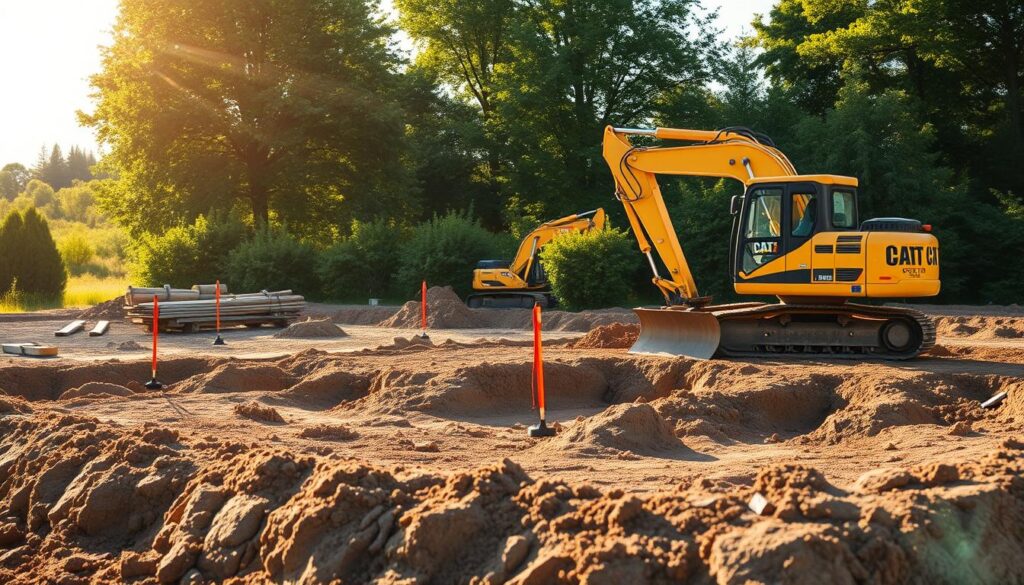Imagine Sarah and Tom, a young couple from Sydney, dreaming of their perfect home. They were tired of the long waits and delays of traditional building. They found a new way with modular construction.
Modular home construction in NSW has changed a lot. It offers a quick and affordable way to build homes. This method is making building homes in Australia faster and more efficient.
It might seem hard to get through the modular construction approval process. But with the right help, it's easy and exciting. This guide will show you how to build a modular home in New South Wales.
Modular home construction is changing the way we build in New South Wales. It uses new, advanced systems that are more efficient and precise. This new method is making homes better and faster to build for everyone.
Off-site construction means building parts in a factory first. This makes homes better and saves time. Prefabricated buildings have many benefits that traditional homes don't.
| Aspect | Modular Construction | Traditional Construction |
|---|---|---|
| Manufacturing Location | Controlled Factory Environment | On-site Construction |
| Construction Time | 30-50% Faster | Standard Timeframe |
| Quality Consistency | High Precision | Dependent on Site Conditions |
The NSW construction market is moving towards modular building systems. Architects, developers, and homeowners see the benefits. They want homes that are high-quality and sustainable.
Modular construction is not just a trend—it's the future of efficient, intelligent building design in Australia.
As technology gets better and we focus on sustainability, modular homes will be key. They will help meet NSW's growing needs for homes.
Getting ready for modular homes in NSW needs careful planning. You must have all the right paperwork to get approval and follow local rules.
Before starting, you need to collect important documents. These show your project is doable and meets technical standards.
In NSW, local councils have their own rules for modular homes. You must apply with a detailed development application. This includes:
| Document Type | Purpose | Required Details |
|---|---|---|
| Site Plan | Location Assessment | Property boundaries, proposed structure placement |
| Structural Drawings | Technical Verification | Detailed construction specifications |
| Compliance Certificates | Regulatory Approval | Building code adherence documentation |
Professional tip: Get a registered building certifier early. They help make sure your documents are right and meet all the rules.
Preparation is key to a successful modular home project in New South Wales.
Modular construction is a new way of building that changes old methods. It uses precise engineering and advanced manufacturing to make quality homes quickly.
The journey of a modular home starts with detailed planning and smart design. Architects and designers work on flexible blueprints that meet modular design needs.
In the initial design phase, experts create detailed plans for offsite manufacturing. They consider:
Offsite manufacturing turns design ideas into real building parts. Factory settings allow for precise construction that beats traditional building.
The modular assembly process includes:
After modules are made, moving and setting them up is key. Skilled teams manage the delivery and placement of pre-built parts, keeping things smooth and fast.
The on-site assembly involves crane work, precise placement, and final connections. This method cuts down construction time a lot compared to old ways.

Understanding local council rules is key when starting a modular home project in NSW. Each area has its own set of rules for building projects. These rules can affect your modular home project.
The modular construction process has several important steps for council approval:
New South Wales councils check modular home applications on several important points:
Talking to local council planners early can make things easier. Homeowners need to show how their modular home fits all local rules.
NSW councils are now more open to modular homes. They see the benefits of prefabricated homes, like being efficient, green, and modern.
"Modular homes represent a forward-thinking approach to residential development," says a NSW planning expert.
To get through council rules, it's best to talk to them early, have all your documents ready, and show you follow local building rules.
Understanding building codes for modular homes is key. In New South Wales, prefabricated buildings must meet strict standards. These ensure safety, quality, and performance.
Building modular homes comes with many rules. These rules are in place to protect the building's strength, energy use, and how well it works.
The National Construction Code (NCC) sets rules for building across Australia. For modular homes, it covers important areas like:
New South Wales has its own rules for prefabricated buildings. These rules help ensure modular homes can handle the state's unique challenges.
| Regulation Category | Key Requirements |
|---|---|
| Structural Integrity | Compliance with AS/NZS 1170 wind and load standards |
| Material Specifications | Approved materials meeting NSW building standards |
| Inspection Protocols | Mandatory quality control checks during manufacturing |
Modular homes must use energy well. The Nationwide House Energy Rating Scheme (NatHERS) helps check how well they keep warm or cool.
Following these standards means modular homes are safe, high-quality, and good for the environment in Australia.

Starting a modular home project needs careful site preparation. The foundation is key for the home's stability and strength. It's important to know your land well before starting.
Site preparation involves a few key steps:
Choosing the right foundation is vital in New South Wales. It depends on the land's condition.
| Foundation Type | Terrain Suitability | Cost Range |
|---|---|---|
| Concrete Slab | Flat, stable ground | $10,000 - $15,000 |
| Pier and Beam | Sloped or uneven terrain | $15,000 - $25,000 |
| Screw Pile | Challenging soil conditions | $12,000 - $20,000 |
Experts say to get a detailed geotechnical report for the best foundation. Good site prep avoids building problems and makes installing the home easier.
Spending time on site prep saves money and effort in building a modular home.
Volumetric construction has its own set of challenges when moving modular homes in New South Wales. It needs careful planning and precision. This ensures a smooth move from the factory to the building site.
For successful modular assembly, several key factors must be coordinated by homeowners and builders.
Transporting modular home parts involves complex logistics:
The modular home installation process has a set timeline:
Safety is top priority during transportation and installation. Professional teams must:
Working with experienced professionals ensures a smooth and safe home installation.
The modular construction approval process is changing how we build in New South Wales. It lets homeowners and developers create homes that are efficient, sustainable, and cost-effective. This method is more flexible and precise than traditional building.
To get through the modular construction approval process, you need to plan well and know the local rules. Every step, from design to installation, requires careful thought about council rules, building codes, and site challenges. Builders should really understand the steps and preparation needed for a successful modular home project.
NSW is moving forward with new building technologies, and modular construction is a key part of this. It makes building faster, reduces waste, and gives more predictable results. As technology improves, modular homes will become even more popular for their efficiency and innovation.
People thinking about building a home should look into modular construction. It offers the chance to build high-quality, sustainable homes that fit the changing needs of Australian communities. The future of building in NSW is looking bright, with modular construction leading the way to smarter homes.


